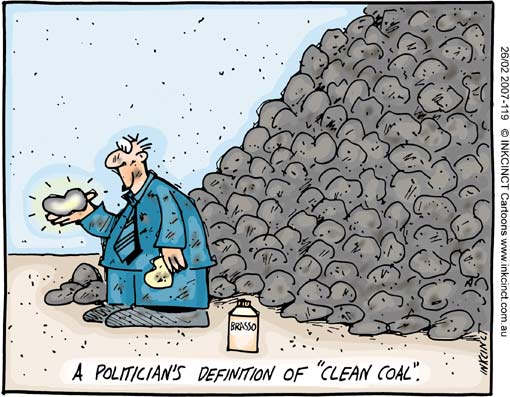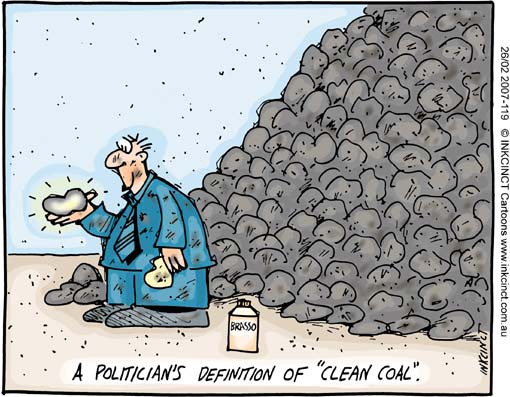So much of us are like the ostrich. Even President Obama. Because in his acceptance speech at the Democratic National Convention he talked about believing in investing in “clean coal.” I won’t say much about the position of the other guy in this Presidential election race because I would like to be considered fair-minded. But…..he believes that there may be something to this “fan-dangled” idea of climate change, but wants more study, and that coal-fired plants need to be built because, gee, gosh, there as “American as apple pie,” just as American as dynamiting the top of a mountain in Appalachia to get to the coal beneath.
And candidate Romney has a whole bunch of Texans backing him up in his belief in coal power because they are trying to beat the EPA’s new clean air regulations by getting three new coal-fired power plants approved before the new standards take affect.
“Clean coal” is to Energy as 9/11 was to Saddam Hussein.
I say this despite the fact that on September 20 the U.S. Department of Energy announced “major milestones” for a Decatur, Illinois, clean coal project. That project is all about a carbon sequestration demonstration facility and the opening of a National Sequestration Education Center.
The sequestration project plans to be able to store 1 million tons of CO2 per year to demonstrate the “feasibility” of carbon capture, utilization and storage (CCUS) technologies.
The quote from Charles McConnell, Assistant Secretary for Fossil Energy, U.S. Department of Energy states,
“This project is an important part of the Obama Administration’s investments in clean coal technology and an all-of-the-above energy strategy that will help ensure we develop every source of American energy….Continued research into Carbon, Capture, Utilization and Storage technologies will help continue reducing the costs of clean coal projects and make sure that the U.S. maintains the lead in this important clean energy industry.”
The project plans to capture CO2, concentrate it and pipe it to an injection well for underground storage in sandstone formations more than 2,100 meters (7,000 feet) underground. I’m not sure what milestones have actually been achieved but the plant will not be operational until the summer of 2013. I would consider that a far more important milestone than the opening of a education centre. But having said that lots of question marks remain about this project and I’ll tell you why.
As I have written before, the economics of CCUS technology without significant government subsidy, make no sense. CCUS remains a black hole that sucks in government money to prop up a continued desire to maintain the fossil fuel industry. Believe me, without subsidies, industry players wouldn’t even give CCUS a second thought.
What is needed is a cap and trade system with a price put on carbon that gets the attention of fossil fuel industry players. A cap and trade system would work like the proverbial carrot and stick to motivate the industry players to alter their behaviour because potential profit could be realized.
So let’s, once and for all, put the “clean coal” misinformation myth to bed along with:
Smoking doesn’t cause cancer.
President Obama was born in Kenya.
Measles, Mumps, Rubella vaccines cause autism in children.
That there is no scientific evidence for global warming.
And that “creation science” is science.
Oh, and that Saddam Hussein had weapons of mass destruction and was responsible for 9/11.











Len says: “As I have written before, the economics of CCUS technology without significant government subsidy, make no sense. CCUS remains a black hole that sucks in government money to prop up a continued desire to maintain the fossil fuel industry. Believe me, without subsidies, industry players wouldn’t even give CCUS a second thought.”
It’s all smoke and mirrors to trick the chickens into believing they will be more secure by allowing more foxes to guard their coops. Should be obvious that cap and trade schemes will only produce more and fatter foxes. The only sorts of workable schemes for actually reducing atmospheric CO2 percentage must either burn less carbonaceous fossil fuel or permanently sequester an offsetting amount of carbon from the atmosphere. Since prosperity depends on, and is roughly proportional to, the amount of fuel burned, reducing the amount of fuel burned is a good formula for reduced prosperity.
The seasonal saw-tooth pattern in the Mona Loa CO2 Lab graphs prove that CO2 anywhere in world is, within just a few months, CO2 everywhere in the world. Hence, bulk harvesting and burying weeds in tropical rain forests removes carbon from the atmosphere in New York and Brussels. Instead of arbitrary government mandated cap and trade of CO2 emissions, just implement government mandated deep ocean or peat bog sequestration of an equal or greater amount of carbon. Emit just as much CO2 as you please, just as long as you bury an equal amount of atmospheric carbon anywhere on Earth.
Large-scale weed farms in the Amazon rain forests could likely sequester carbon at costs near $10/ton. Just compress the cellulose into 500-pound bails with specific gravity of 0.97, barge the bails down the river out to the deep ocean, and then dump the bails overboard. So for every ton of carbon emitted by a coal-fired power plant in China, India, or Indiana, the emitter would pay the Amazon weed farmer $10 plus a few dollars profit. No complicated smoke and mirrors and global CO2 levels begin to decline as mountains of cellulose bails begin to pile up on the mile-deep ocean floor. If you think the “bails on the bottom” scheme too technically iffy, just turn the tropical weeds into charcoal and burn the tropical charcoal in your New Jersey power plant. There are many variations on the theme (creation of giant artificial peat bogs in rain forests is almost trivial), but the central idea is that photosynthesis is always going to be the cheapest form of atmospheric carbon removal, and it matters not at all where on Earth the photosynthesis occurs.
One might argue that we are burning “buried sunshine” stored up over millions of years, and that we are burning it up many times faster than present photosynthesis can replace it. But that is entirely counterfactual. See the scientifically competent treatment at: http://globalecology.stanford.edu/DGE/Dukes/Dukes_ClimChange1.pdf
Mankind burns fossil fuels at a rate only 22% of present global photosynthesis, and that’s based on only 1.5% photosynthetic conversion efficiency. With crops such as sugarcane, 3-5% conversion is feasible. So in principle, cultivation of rapid growing high conversion efficiency tropical “weeds,” say something like genetically engineered sugarcane, could completely offset the planet’s entire fossil fuel emissions. I’m partial to the simple tropical $10/ton “bails on the bottom” approach, but I wouldn’t resist $80/ton tropical charcoal burned in power plans across the globe Tropical charcoal would truly be “clean coal,” but “big coal” and “cap and trade” factions would likely lobby for a $100/ton import tariff.
There are a number of schemes to bury carbon at sea. See my blog posting, https://www.21stcentech.com/geoengineering-reworking-our-planets-atmosphere-in-the-21st-century/ in which I describe some of the proposed solutions.
In your description of the process of using Amazon rainforest farmers to sequester carbon you are indeed supporting what would be the end result of a cap and trade system. We can assume greed will continue to drive human behaviour and a system that can make sequestration feed the bottom line of both emitters and those who conserve is workable. Determining the right price for carbon to ignite a market-driven carbon exchange should help us reduce CO2 over time.
The idea of developing high-sequestering GMO plants that can serve as well as a source of food would be an interesting development. I wonder if anyone is working on this. Certainly worth checking out.
The assumption of the Duke paper that we are running out of fossil fuel is a “peak oil” statement that has yet to be proven valid. But otherwise I like the potential of what is proposed.
I linked the Duke paper only as a scientific reference to the ratio of photosynthetic fixation of carbon in contrast to fossil fuel emissions. In principle, unless photosynthesis is fixing several times more carbon than fossil fuel combustion is releasing, sequestration of photosynthetic carbon offers no solution to rising atmospheric CO2 levels. The Duke paper shows that in principle there is enough present photosynthetic fixation of carbon to offset fossil fuel emissions.
I don’t hold strong convictions about either abiotic oil or peak oil. I do think Duke’s treatment of coal is credible. Ultimately, some mixture of immediate nuclear and solar power, not buried sunlight, will provide the world’s energy base, but we seem at least 50-years away from that. Deep horizontal drilling and high pressure fracturing technology has greatly expanded fossil oil and gas reserves, and it seems unlikely we will soon exhaust those reserves. Even if we must eventually use nuclear, solar, and wind energy to electrolyze hydrogen out of water and convert limestone into gasoline, jet, and diesel fuel, for the foreseeable future, nothing is likely to significantly replace the present liquid hydrocarbon transportation fuels.
Unfortunately I agree with your conclusions. We remain bound to fossil fuels for the foreseeable future.